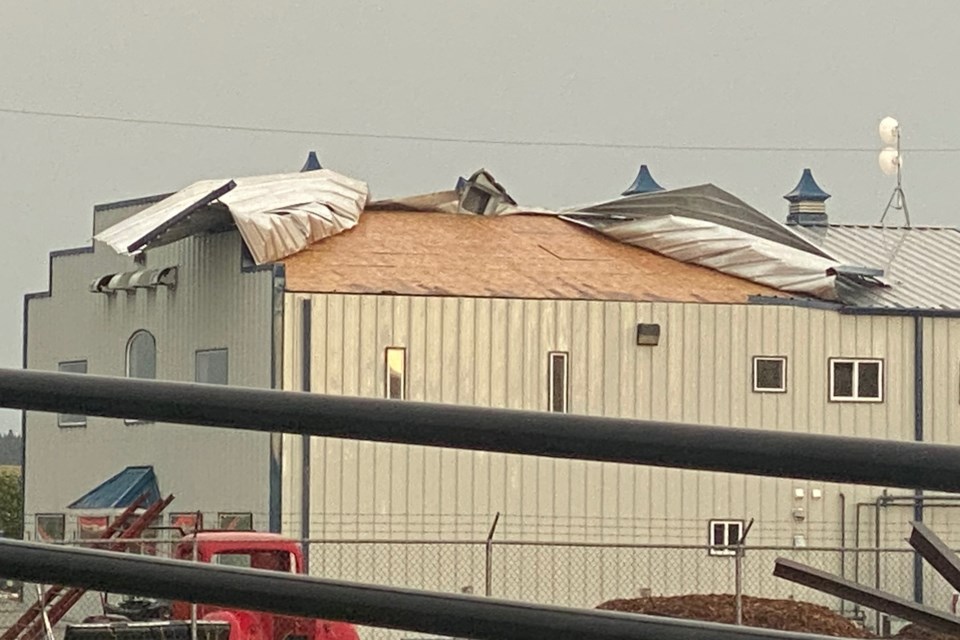SUNDRE — The powerful storm that recently swept through the region broke more than the stifling heatwave that had seen sweltering temperatures reach the high-30 C range.
The municipality’s operations building in the southwest industrial district sustained substantial damage on Friday, July 2 as a result of the powerful storm that swept through the region.
“Luckily, this is what we have insurance for,” Chris Albert, director of corporate services, said on July 8 in response to emailed questions.
“The damage to the operation’s building is actually quite substantial. Not only was a large section of the tin roofing peeled back, but because of that a lot of rain entered the building.
"The interior drywall of the walls and ceiling in the main training and entrance area are completely saturated, including the insulation underneath."
Additionally, the various offices and desk areas in the building also sustained some water damage, although the municipality did not immediately know the full extent until all the damaged material was removed, he said.
Fortunately, the damage appeared to have been largely contained to the front portion of the structure, leaving the main shop and equipment maintenance area essentially untouched, he said.
A roofing company was brought in to complete emergency repairs to the roof to provide a temporary seal to protect the building as best as possible from any further damage, he said.
“Staff, desks, paperwork and electronic equipment have been relocated to other locations so staff can continue working. A restoration company has begun some initial activities to dry out the space and clean up any residual water,” he said.
When Albert responded to The Albertan, he said an adjuster had already been out to start assessing the extent of the damage, and that the process remained in the hands of the insurance company to review the file and determine what would be required.
“So, at this time, we do not have information on repair estimates or any potential cost,” he said.
If any of the costs end up not being covered by insurance and the town has to find funding for any of the repairs, Albert said a request would be brought to council for a decision as soon as that information becomes available.
“Horizontal rain”
Jim Hall, operations manager, said he was still working with a colleague on July 2 at about 5:30 p.m. when the storm suddenly kicked up.
“We had some horizontal rain, if you will,” he said, adding the powerful winds “peeled the west-facing roof off of our shop.”
As a result, rain subsequently began to pour into the building’s main foyer area, he said.
“The internal damage to the office section of the shop is quite extensive and we are currently working through the process of getting things removed cleaned.”
Trees felled
In the storm’s immediate wake, a local professional tree pruner with a background in forestry said he received about five calls.
In one of those instances, Alfred Schmutz removed a tree that had fallen onto a holiday trailer in Sundre’s Riverside RV Park.
"But the way the tree fell, it was actually quite amazing,” he said.
The bulk of the felled tree’s weight, he explained, ended up being borne by a spruce tree.
“So, the impact on the trailer was very minor,” he said. “I took that tree off the trailer the day after the storm.”
Diligent preventative maintenance such as removing potentially problematic trees can go a long way toward reducing the impact of such storms, he said.
Trees that are diseased or otherwise struggling often exhibit signs of rot, and those are the ones that should be dealt with, he said.
“There’s always a few which look perfectly healthy, and then they do blow over,” he added.
“But if a large park has maybe just a few trees coming down, that’s not too bad.”
Meanwhile, Tall Timber Leisure Park largely dodged the proverbial bullet.
The recreational resort’s manager, Charlene Siegfried, said no significant damage was sustained.
“We were very well off this time, which was nice,” said Siegfried, adding the resort has retained the services of a company that removes potentially problematic trees. “We do a lot of preventative measures."
Maintaining balance
One of his biggest challenges when carrying out preventative work, said Schmutz, is always being mindful to leave standing as many trees as possible.
“On private properties where there’s space, we sometimes identify trees which may be suspect to blow down. But because they’re out of reach of (structures), we just leave them standing,” he said.
With his past experience in forestry, Schmutz said a tree stand — or a grouping of trees — is much stronger and more resilient against powerful winds when in greater numbers.
“A stand will sustain a lot more winds than if the trees are exposed,” he said.



